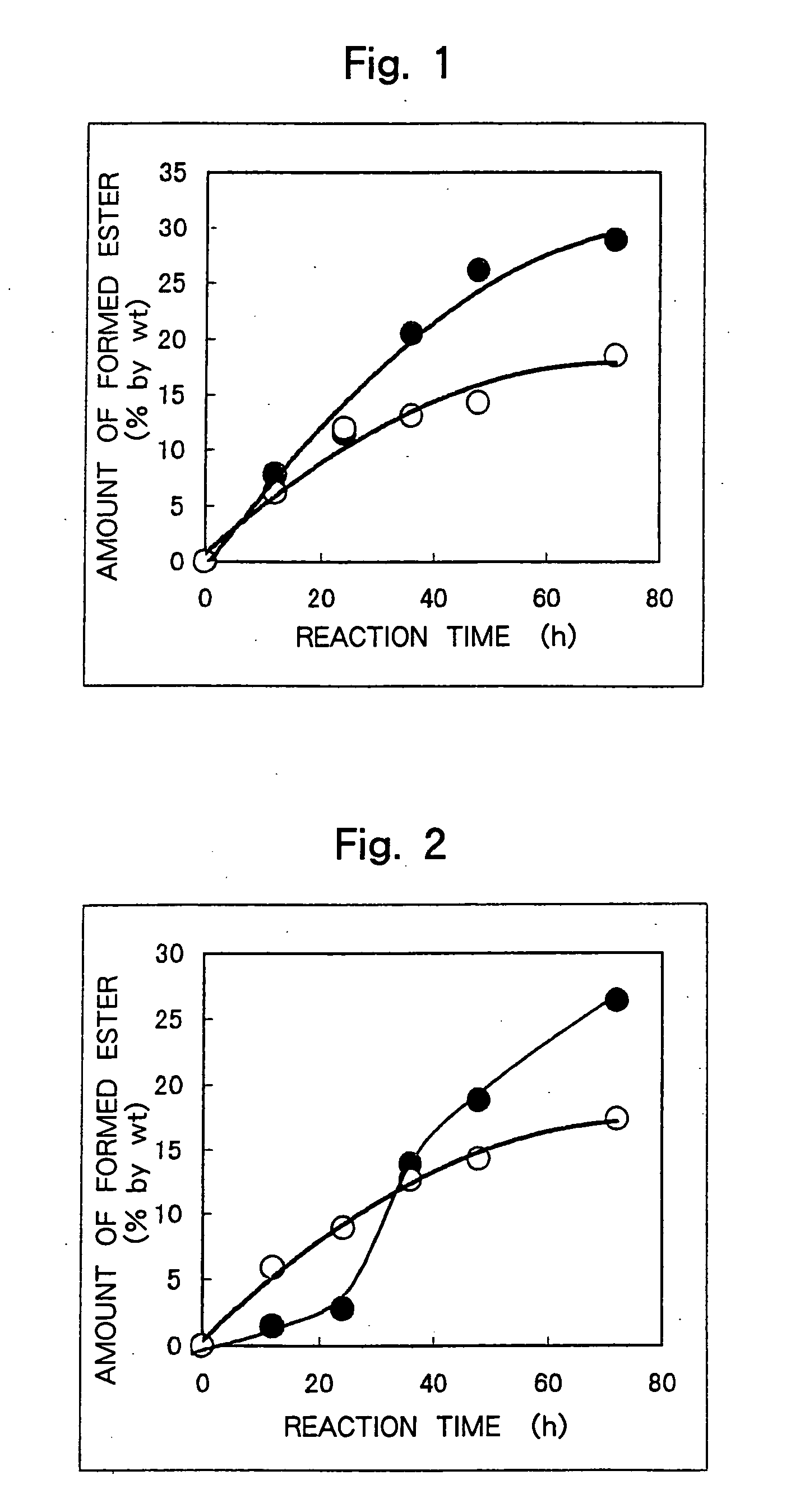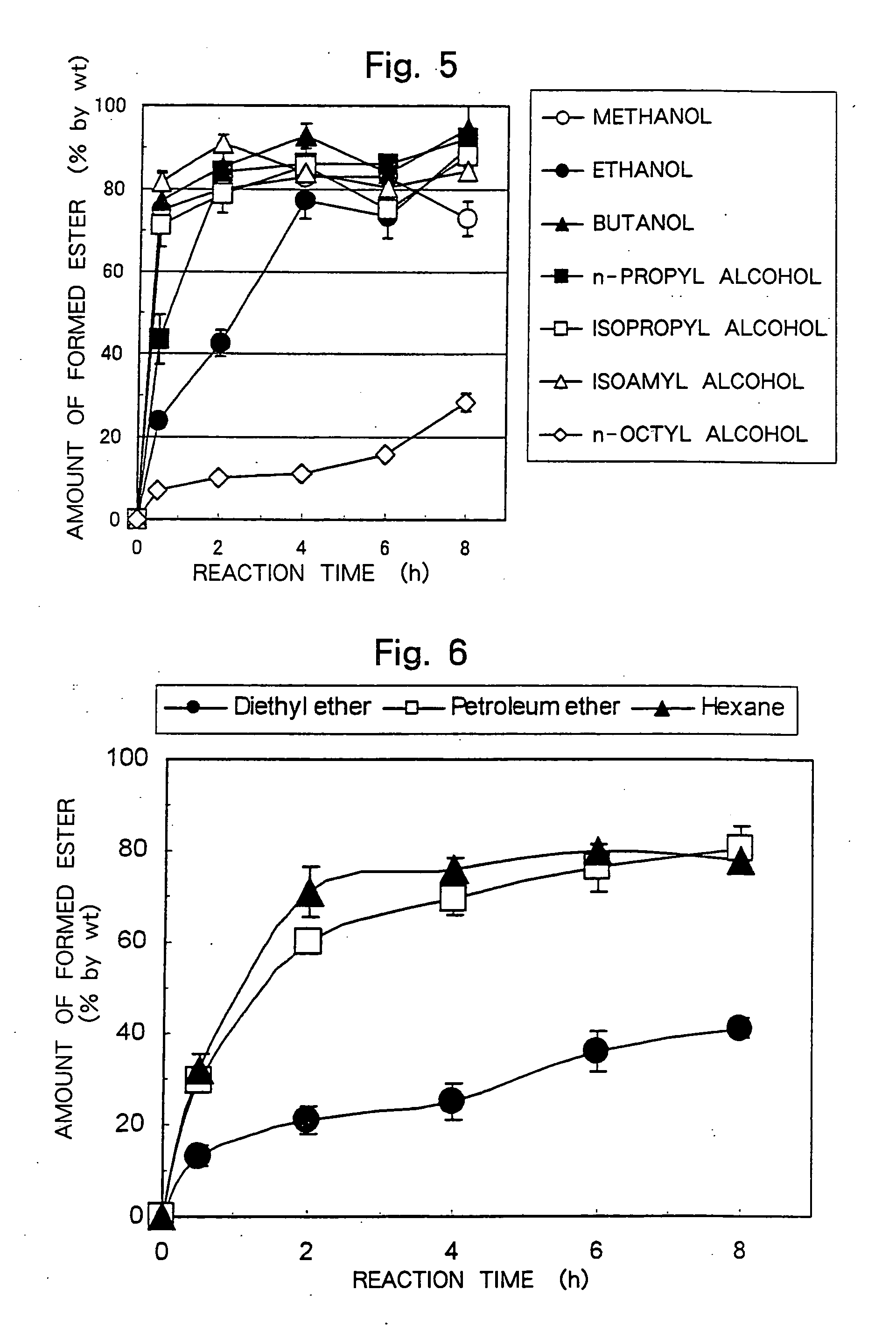Method of producing bio-fuels
a biofuel and biofuel technology, applied in the field of biofuel production methods, can solve problems such as very difficult handling
- Summary
- Abstract
- Description
- Claims
- Application Information
AI Technical Summary
Benefits of technology
Problems solved by technology
Method used
Image
Examples
example 1
[0082] Into a 100-ml flask were introduced 11.0 g of a waste clay (activated clay of after having decolored the rape oil, oil content of 33% by weight, saponification value of oil of 181), 1 ml of a solution of the sample R-1 (enzymatic activity of 201 IU / ml), 1.25 ml of a buffer solution (pH=7.0) and methanol of a concentration of 4.75 millimols, and the mixture was reacted at 35° C. with stirring at 175 rpm for 72 hours. After the reaction, 200 μl of the reaction product was taken out and to which was added 1.0 ml of hexane. The mixture was vigorously stirred and was subjected to the centrifugal separation at 10,000 rpm for 5 minutes to separate the hexane layer. Next, the reaction product was dissolved in 1.0 ml of acetonitrile, and a methyl ester thereof was analyzed with a gas chromatography. The results were as shown in Table 3 and in FIG. 1 (black circles).
example 2
[0084] Into a 100-ml flask were introduced 11.0 g of a waste clay (activated clay of after having decolored the soybean oil, oil content of 33% by weight, saponification value of oil of 188), 1 ml of a solution of the sample R-1 (enzymatic activity of 201 IU / ml), 1.25 ml of a buffer solution (pH=7.0) and methanol of a concentration of 4.75 millimols, and the mixture was reacted at 35° C. with stirring at 175 rpm for 72 hours. After the reaction, 2.00 μl of the reaction product was taken out and to which was added 1.0 ml of hexane. The mixture was vigorously stirred and was subjected to the centrifugal separation at 10,000 rpm for 5 minutes to separate the hexane layer. Next, the reaction product was dissolved in 1.0 ml of acetonitrile, and a methyl ester thereof was analyzed with a gas chromatography. The results were as shown in Table 4 and in FIG. 2 (black circles).
example 3
[0086] Into a 100-ml flask were introduced 11.0 g of a waste clay (activated clay of after having decolored the palm oil, oil content of 33% by weight, saponification value of oil of 176), 1 ml of a solution of the sample R-1 (enzymatic activity of 201 IU / ml), 1.25 ml of a buffer solution (pH=7.0) and methanol of a concentration of 4.75 millimols, and the mixture was reacted at 35° C. with stirring at 175 rpm for 72 hours. After the reaction, 200 μl of the reaction product was taken out and to which was added 1.0 ml of hexane. The mixture was vigorously stirred and was subjected to the centrifugal separation at 10,000 rpm for 5 minutes to separate the hexane layer. Next, the reaction product was dissolved in 1.0 ml of acetonitrile, and a methyl ester thereof was analyzed with a gas chromatography. The results were as shown in Table 5 and in FIG. 3 (black circles).
PUM
 Login to View More
Login to View More Abstract
Description
Claims
Application Information
 Login to View More
Login to View More - R&D
- Intellectual Property
- Life Sciences
- Materials
- Tech Scout
- Unparalleled Data Quality
- Higher Quality Content
- 60% Fewer Hallucinations
Browse by: Latest US Patents, China's latest patents, Technical Efficacy Thesaurus, Application Domain, Technology Topic, Popular Technical Reports.
© 2025 PatSnap. All rights reserved.Legal|Privacy policy|Modern Slavery Act Transparency Statement|Sitemap|About US| Contact US: help@patsnap.com



